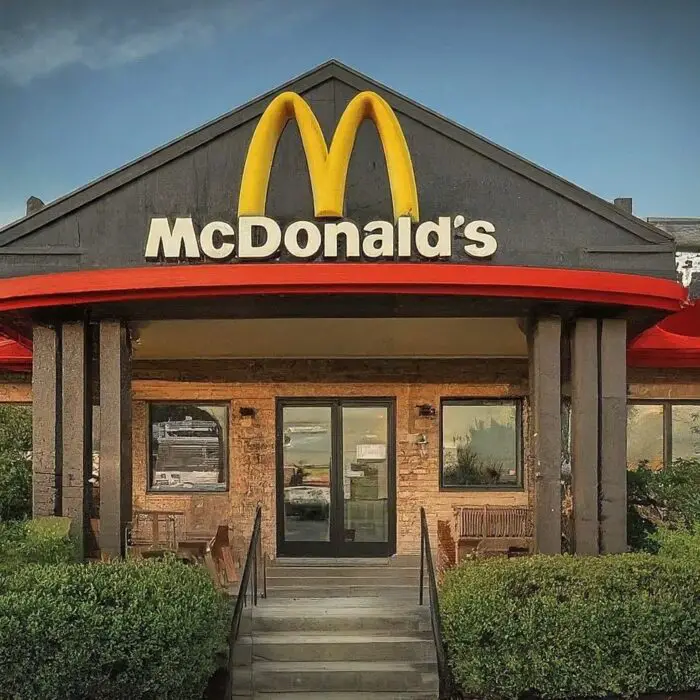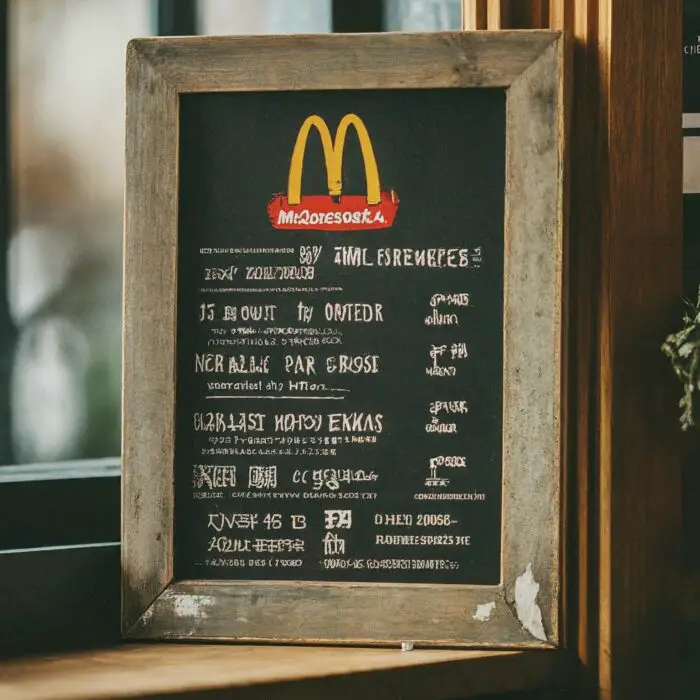
Entrance to a McDonald’s restaurant.
Key Takeaways
- Innovation and Adaptability: Continuous evolution of menu and technology integration.
- Consistency and Quality: Standardized procedures ensure consistent experiences.
- Global Presence: Strong international footprint with localized offerings.
- Customer Engagement: Effective marketing and technology use for enhanced customer experience.
- Sustainability Initiatives: Focus on environmental responsibility and sustainable practices.
Introduction
McDonald’s, a global fast-food giant, has managed to stay relevant in the highly competitive fast-food industry for decades.
Its ability to innovate, maintain quality, expand globally, engage customers effectively, and commit to sustainability has kept it ahead of the curve.
This article delves into how McDonald’s has maintained its relevance and continued to thrive in the ever-changing market.
Innovation and Adaptability
Continuous Menu Evolution
McDonald’s consistently updates its menu to cater to changing consumer preferences and market trends:
- New Product Introductions: Items like the McPlant, McSpicy, and seasonal favorites keep the menu fresh.
- Healthy Options: Includes salads, fruit, and low-calorie meals to appeal to health-conscious customers.
- Limited-Time Offers: Exciting promotions and collaborations attract customers.
Technology Integration
Leveraging technology to enhance customer experience is key to McDonald’s strategy:
- Mobile App: Offers mobile ordering, exclusive deals, and loyalty rewards.
- Self-Service Kiosks: Reduces wait times and allows for personalized orders.
- Delivery Services: Partnerships with Uber Eats and DoorDash expand accessibility.

A menu stand
Consistency and Quality
Standardized Procedures
McDonald’s ensures consistent quality across all locations through standardized procedures:
- Quality Control: Strict measures ensure food safety and taste.
- Employee Training: Comprehensive training programs maintain high service standards.
- Reliable Supply Chain: A robust supply chain ensures fresh ingredients and efficient operations.
Customer Trust
Consistency builds customer trust and loyalty:
- Predictable Experience: Customers know they will receive the same quality and service wherever they go.
- Brand Loyalty: Reliable quality fosters strong brand loyalty and repeat business.
Global Presence
Strong International Footprint
McDonald’s has a vast international presence, adapting its offerings to local tastes:
- Over 38,000 Locations: Operates in more than 100 countries.
- Localized Menus: Offers menu items tailored to regional preferences, such as the Teriyaki Burger in Japan or the Maharaja Mac in India.
- Cultural Adaptation: Incorporates local flavors and ingredients while maintaining core offerings.
Benefits of Global Reach
- Brand Recognition: The golden arches are universally recognized.
- Market Penetration: Strategic location placements ensure high visibility and accessibility.

Burgers
Customer Engagement
Effective Marketing
McDonald’s employs robust marketing strategies to engage customers:
- Iconic Advertising: Memorable ads and jingles that resonate with audiences.
- Social Media Presence: Active on platforms like Instagram, Twitter, and Facebook to connect with customers.
- Promotions and Deals: Attracts customers with special promotions, discounts, and loyalty programs.
Technology and Convenience
Utilizing technology to enhance convenience and customer satisfaction:
- Mobile Ordering: Allows customers to order ahead and pick up at their convenience.
- Curbside Pickup: Introduced during the pandemic to enhance safety and convenience.
- Contactless Payment: Provides a seamless and secure payment process.
Sustainability Initiatives
Environmental Responsibility
McDonald’s is committed to sustainability and reducing its environmental impact:
- Sustainable Sourcing: Focuses on sustainable beef, coffee, and fish sourcing.
- Packaging Innovations: Reducing plastic use and increasing recyclable materials.
- Energy Efficiency: Implementing energy-efficient practices in restaurants.
Benefits of Sustainability
- Consumer Support: Appeals to environmentally conscious customers.
- Corporate Responsibility: Demonstrates commitment to global sustainability goals.
Table: Comparison of McDonald’s Key Strategies
| Strategy | McDonald’s Approach | Competitor Approach |
|---|---|---|
| Menu Innovation | Regular new items, healthy options, limited-time offers | Varies, often slower to introduce new items |
| Technology Integration | Mobile app, self-service kiosks, delivery services | Many have apps, but fewer have extensive tech integration |
| Consistency and Quality | Standardized procedures, strict quality control | Varies, with some struggling with consistency |
| Global Presence | Over 38,000 locations, localized menus | Many have fewer locations and less localization |
| Customer Engagement | Effective marketing, social media presence, promotions | Varies, some have strong marketing but less tech use |
| Sustainability | Sustainable sourcing, packaging innovations, energy efficiency | Varies, with some less focused on sustainability |
Conclusion
McDonald’s has maintained its relevance in the fast-food industry through a combination of innovation, consistency, global reach, customer engagement, and sustainability.
By continuously evolving its menu and leveraging technology, McDonald’s meets the changing needs of its customers while maintaining high standards of quality.
Its strong international presence and effective marketing strategies ensure that McDonald’s remains a favorite across the globe.
Furthermore, the company’s commitment to sustainability resonates with environmentally conscious consumers, securing its position as a leader in the industry. As competitors strive to catch up, McDonald’s continues to set the benchmark for success in the fast-food world.

